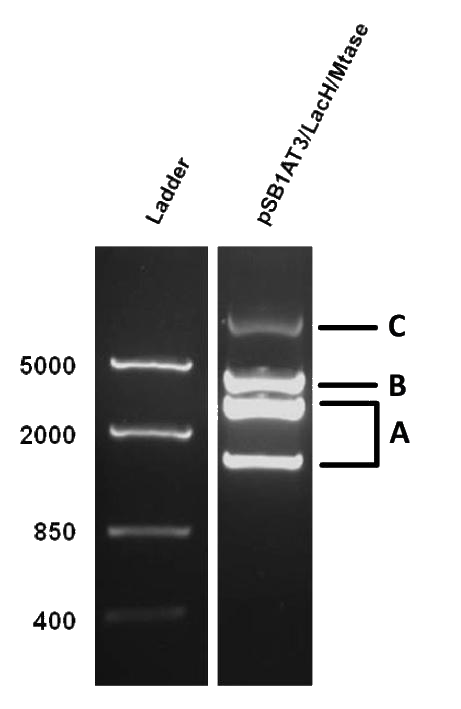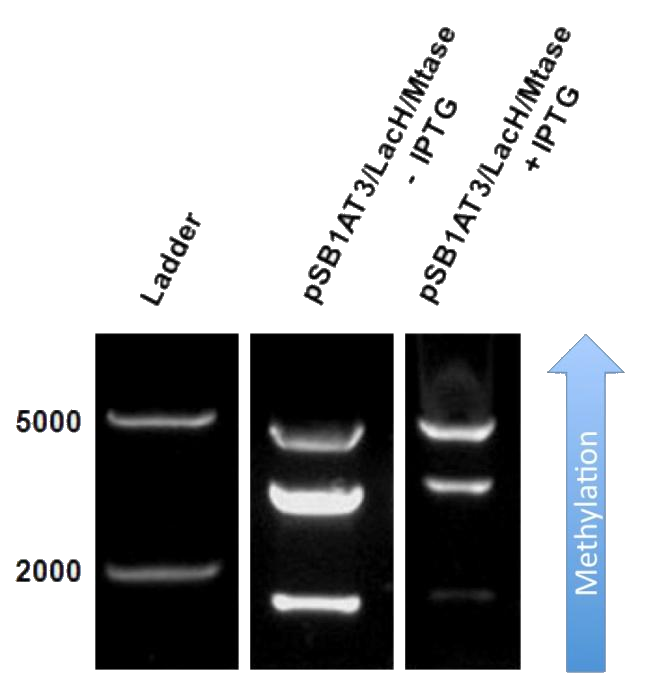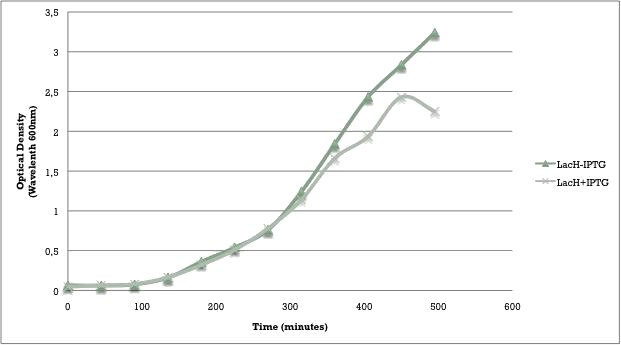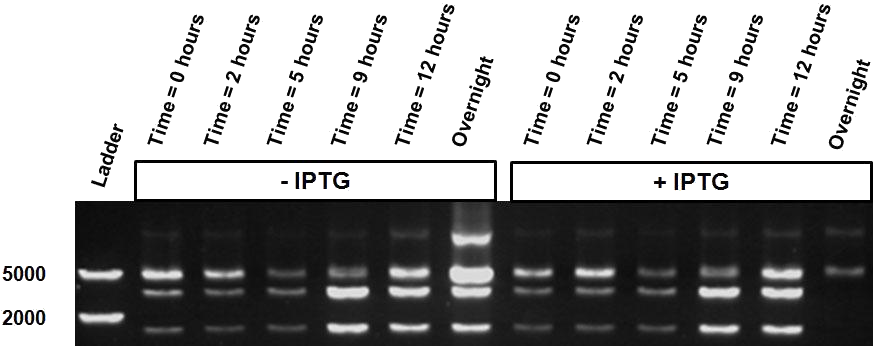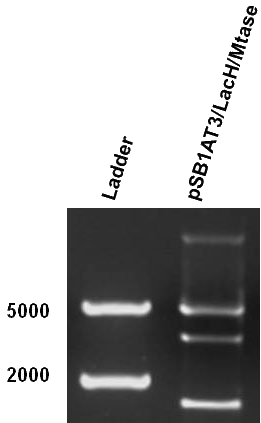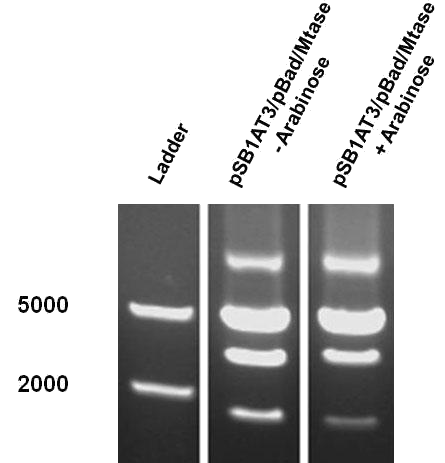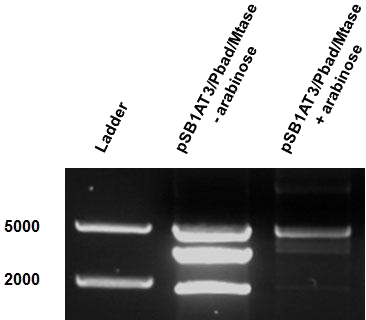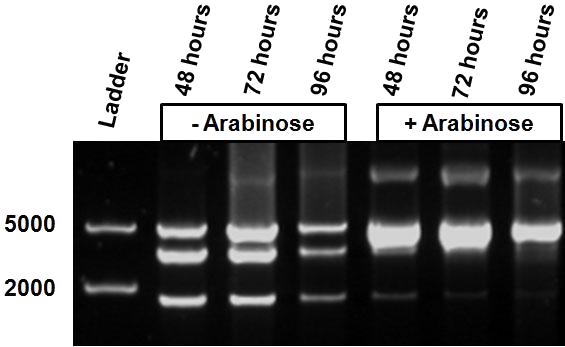Team:Amsterdam/data/experimental
From 2012.igem.org
(Difference between revisions)
| Line 62: | Line 62: | ||
<h4>Behavior of the writer-reader module under tight control of and arabinose-regulated promoter</h4> | <h4>Behavior of the writer-reader module under tight control of and arabinose-regulated promoter</h4> | ||
| + | [[File:Amsterdam_exp_fig_7.png|300px|right|thumb|Figure 7]] | ||
The Cellular Logbook was further characterized using the pBad promoter. This promoter was chosen in order to overcome the leakiness observed with the LacH promoter. Expression of any gene cloned behind the pBad promoter is controlled by the AraC repressor and is considered to be fully suppressed in the absence of arabinose. However, in the presence of arabinose the promoter will generate a gradual response leading to gene expression. | The Cellular Logbook was further characterized using the pBad promoter. This promoter was chosen in order to overcome the leakiness observed with the LacH promoter. Expression of any gene cloned behind the pBad promoter is controlled by the AraC repressor and is considered to be fully suppressed in the absence of arabinose. However, in the presence of arabinose the promoter will generate a gradual response leading to gene expression. | ||
| - | [[File: | + | [[File:Amsterdam_exp_fig_8.png|300px|right|thumb|Figure 8]] |
| - | + | ||
The first characterization experiment involved induction of pSB1AT3/pBad/Mtase in Library Efficient® DH5α™ competent cells (Invitrogen) in stationary phase with 1 % arabinose. The construct was digested with ScaI restriction enzyme after 24 hours incubation at 37˚C. Surprisingly, the same intermediate digestion profile as the LacH was observed. A combination of different restriction profiles can be inferred from the results (figure 7). In the absence of arabinose, M.ScaI methyltransferase appears to be expressed and a significant number of plasmids present in the culture are fully methylated, accounting for the intense uncut DNA fragment observed. A similar pattern was observed in the presence of arabinose. | The first characterization experiment involved induction of pSB1AT3/pBad/Mtase in Library Efficient® DH5α™ competent cells (Invitrogen) in stationary phase with 1 % arabinose. The construct was digested with ScaI restriction enzyme after 24 hours incubation at 37˚C. Surprisingly, the same intermediate digestion profile as the LacH was observed. A combination of different restriction profiles can be inferred from the results (figure 7). In the absence of arabinose, M.ScaI methyltransferase appears to be expressed and a significant number of plasmids present in the culture are fully methylated, accounting for the intense uncut DNA fragment observed. A similar pattern was observed in the presence of arabinose. | ||
| - | + | [[File:Amsterdam_exp_fig_9.png|300px|right|thumb|Figure 9]] | |
The second characterisation experiment involved the induction of pSB1AT3/pBad/Mtase in Efficient® DH5α™ competent cells (Invitrogen) in stationary phase with 2 % arabinose and incubation at 37˚C for 48 hours. Subsequent digestion with ScaI restriction enzyme showed a shift towards the uncut restriction profile (figure 8). This result shows that under these conditions the writer-reader is optimally functional. Succes! | The second characterisation experiment involved the induction of pSB1AT3/pBad/Mtase in Efficient® DH5α™ competent cells (Invitrogen) in stationary phase with 2 % arabinose and incubation at 37˚C for 48 hours. Subsequent digestion with ScaI restriction enzyme showed a shift towards the uncut restriction profile (figure 8). This result shows that under these conditions the writer-reader is optimally functional. Succes! | ||
| - | |||
| - | |||
| - | |||
| Line 82: | Line 79: | ||
Similarly to the pSB1AT3/LacH/Mtase, a growth curve experiment was conducted to characterize the acquired construct of pSB1AT3/pBad/Mtase. | Similarly to the pSB1AT3/LacH/Mtase, a growth curve experiment was conducted to characterize the acquired construct of pSB1AT3/pBad/Mtase. | ||
| - | + | [[File:Amsterdam_exp_fig_7.png|300px|right|thumb|Figure 10]] | |
Over the course of time the methylation-dependent restriction profile observed in the gel showed a shift towards the ‘on’ digestion profile in the presence of arabinose. This result shows that our Cellular Logbook is able to sense and write an arabinose signal present in the medium in a shorter period of time. | Over the course of time the methylation-dependent restriction profile observed in the gel showed a shift towards the ‘on’ digestion profile in the presence of arabinose. This result shows that our Cellular Logbook is able to sense and write an arabinose signal present in the medium in a shorter period of time. | ||
Revision as of 02:42, 27 September 2012
 "
"






